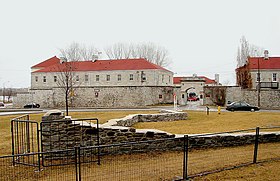Fort Cataraqui
| Fort Frontenac (formerly Fort Cataraqui) | |
|---|---|
| Part of chain of French forts throughout Great Lakes and upper Mississippi region. | |
| Mouth of Cataraqui River, Kingston, Canada | |

Remnants of the old fort with the new Fort Frontenac in background
|
|
| Site information | |
| Controlled by | Original: New France |
| Condition | Present fort: military barrack buildings used as college. Remnants of original stone fort can be seen. |
| Site history | |
| Built | 1673 |
| Built by | Louis de Buade de Frontenac |
| In use | 1673– present. Periods of abandonment. |
| Materials | Original: wood palisade, partially rebuilt with stone in 1675, rebuilt completely of stone 1695. |
| Demolished | 1689 but later rebuilt. Destroyed by British, 1758. Partly rebuilt, 1783. |
| Battles/wars | Iroquois siege, 1688, Battle of Fort Frontenac (Seven Years' War), 1758 |
| Garrison information | |
| Occupants | French, British, Canadian |
Fort Frontenac was a French trading post and military fort built in 1673 at the mouth of the Cataraqui River where the St. Lawrence River leaves Lake Ontario (at what is now the western end of the La Salle Causeway), in a location traditionally known as Cataraqui. It is the present-day location of Kingston, Ontario, Canada. The original fort, a crude, wooden palisade structure, was called Fort Cataraqui but was later named for Louis de Buade de Frontenac, Governor of New France who was responsible for building the fort.
The British destroyed the fort in 1758 during the Seven Years' War and its ruins remained abandoned until the British took possession and reconstructed it in 1783. The fort was turned over to the Canadian military in 1870–71 and it is still being used by the military.
The intent of Fort Frontenac was to control the lucrative fur trade in the Great Lakes Basin to the west and the Canadian Shield to the north. It was one of many French outposts that would be established throughout the Great Lakes and upper Mississippi regions. The fort was meant to be a bulwark against the English who were competing with the French for control of the fur trade. By constructing the trading post the French could encourage trade with the Iroquois, who were traditionally a threat to the French because of their alliance with the English. Another function of the fort was the provision of supplies and reinforcements to other French installations on the Great Lakes and in the Ohio Valley to the south.
Explorer René Robert Cavalier de La Salle was ordered by governor Daniel de Rémy de Courcelle to select a location for a fort. He selected the strategic junction of Lake Ontario, the Cataraqui River, and the St. Lawrence River. Governor Louis de Buade de Frontenac, de Courcelle's successor, was concerned about further Iroquois threats, and endorsed La Salle's proposal. Indeed, governor Frontenac and his close associates hoped to personally benefit from building the fort by controlling trade. Frontenac, along with his entourage, journeyed up the St. Lawrence to the fort's future site where he met leaders of the Five Nations of the Iroquois on July 12, 1673 to encourage them to trade with the French, and to begin the fort's construction. The fort, which was constructed of wood surrounded by a wooden consisting of sharpened poles, was completed within six days. La Salle administered the fort and built storage buildings and dwellings, brought in domestic animals and ensured some land outside the fort was cultivated with the aim of attracting settlers.
...
Wikipedia
